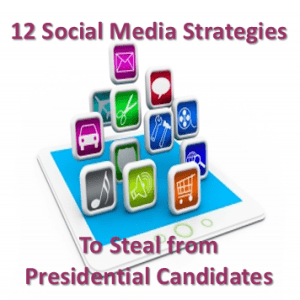 Want to learn how to do digital fundraising? I’ve added my own thoughts to an assessment of GOP presidential candidates’ digital strategies by Marketing Profs to give you some great takeaways as to what is currently resonating online.
Want to learn how to do digital fundraising? I’ve added my own thoughts to an assessment of GOP presidential candidates’ digital strategies by Marketing Profs to give you some great takeaways as to what is currently resonating online.
The candidates know how important a killer digital strategy is when it comes to finding and connecting with potential supporters, and the importance of digital was confirmed by a recent study from Pew Research. So they’re all doing it, some more successfully than others. Nonprofits can learn by studying what works; what doesn’t.
What You Can Learn
The social media champion to-date is Donald Trump. Love him or hate him, Donald Trump’s staff knows exactly what they’re doing.
Remember when getting media attention meant a choice between paid advertising or press releases and p.r. events to earn free press? Today’s options are broader. And Trump, with the help of his 29-year-old media coordinator, excels at earning media attention through social media. His larger than life “persona” thrives in the spotlight.
He knows exactly who he is. His Twitter account sounds like it comes directly from him, and he uses social media for quick, laser-focused quips, retorts and comebacks that have turned him into a media sensation.
Even though his content is controversial, he just keeps pushing it out there. He uses all the best tactics to get his message across, making it more about his persona than his content.
And he’s everywhere. All with his “I’m the greatest” and “I’ll get it done” approach. He presented his tax plan on Periscope. He rallies crowds on Twitter and Facebook. He hosted a live Q&A with the hashtag #AskTrump and responded to questions with individual videos. He’s never far from the limelight.
Ted Cruz uses crowdfunding and gamification to his advantage. He’s used Cruz Crowd to enable fans to recruit friends (called “patriots”) to their personal Cruz Crowd donation pages. Then, using Facebook and Twitter, folks can monitor how much they’ve raised. And they can earn game badges to showcase their efforts. There’s even an app that, once downloaded, awards action points to “players” for sending invites and taking other actions through the app.
Ben Carson excelled early in the game at getting people who barely knew him to take action. His staff posts petitions and polls on Facebook as a strategy to get new emails to build their mailing list. For example, one petition on Facebook to stop the Iran deal drew 300,000 signers who all gave their emails to the campaign.
Marco Rubio’s digital presence is defined by his use of online storytelling and content marketing to showcase his persona and show he is listening to his audience. His Twitter stream is personal and he retweets a fair amount, using his supporter’s content for his own.
Jeb Bush has a rather tepid presence, showing that you can’t do this in fits and starts. He began great, announcing his candidacy through Snapchat and promoting his PAC on Instagram. But then he faded away on the newer channels, ending up with a so-so social media presence overall compared with his GOP rivals. He does use Twitter, but tends to shun the limelight and sticks to posts that are sharply issue-focused. Facts. Data. Efficiency in government. Core values. At first blush, this might seem noble, straightforward and practical. But it ends up being similar to businesses and nonprofits who tweet dry stuff about their mission statement and strategic plan. These types of communications don’t stir people’s emotions. They don’t connect. They don’t “stick.”
Hillary Clinton has excelled at using real-time social media during the debates. Her support team prepares tons of content based on her stump speech talking points, sending out hundreds of pre-vetted tweets and graphics which only require small tweaks before their timely post.
Her team also uses a data-driven approach pioneered by the Obama campaign. Whenever her campaign tweets issue specific messaging, it includes a shortened URL linked to a trackable, issue-specific sign-up page. This increases the potential user’s engagement and likelihood of signing up. It also allows the campaign to identify these potential donors and volunteers by the issues that brought them into the campaign and ultimately to use that data to buy targeted programmatic advertising buys and send targeted emails to these voters in the future.
In terms of persona, her campaign has courted Millenials by having her speak appropriate language on all relevant apps. For example, since its April launch her campaign has partnered with Bitmoji to create a Hillary-themed avatar on Instagram; asked followers to tweet their feels on student debt “in 3 emoji or less”; tweeted an ice-cold GIF of Hillary appearing to brush off her shoulder during the Benghazi hearings; Snapchatted the “praise hands emoji” in a diverse array of skin tones, and more.
12 Winning ‘Take-Away’ Digital Strategies
- Develop an authentic persona that connects with your audiences; don’t be robotic.
- Troll the media using digital platforms—it’s the most cost-effective way to get mainstream media mentions.
- Build your email list using calls to action such as petitions and polls.
- Send issue-specific links that send potential supporters to trackable landing pages; use this data to identify which issues drew these folks to your site.
- Using crowdfunding and gamification to engage folks and spur action.
- Turn fans into “social media ambassadors”; reward advocates for their actions.
- Be responsive; take time to reply to comments.
- Consider streaming “live chat” platforms to demonstrate your human connection.
- Follow your fans; show you’re paying attention through retweets.
- Use storytelling to define your brand; Stay away from dull, fact-based content that fails to stir emotions.
- Be consistent and persistent.
- Come from the heart, not the head.
Conclusions:
- It’s never too late to venture into new territory. Nothing ventured nothing gained; make it a practice to try out some new social strategies this year.
- When you do, give it your all for a pre-determined period of time (I suggest 18 months for nonprofits) to see if it gains traction and pays off.
- Use content that evokes emotion and makes people feel something – angry, sad or happy.
- Carefully consider the overall impression you’re making. Who are you? What do you stand for?
- Answer your audiences’ questions by creating a warm social media persona that connects with your audience.
Do these five things thoughtfully and consistently and you’ll make a good first, second, third and lasting impression!
Images courtesy of Vectorolie, Freedigitalphotos.net











Really good stuff here and thank you for posting the analysis of what the presidential candidates are doing. Great to know.
Can you please expand on ” Troll the media using digital platforms’ – I am not clear what you are suggesting.
Also, could you please look into why my iPhone shortcuts will not work when completing the data entry below with my name and email address.
Follow the media and invite them to interact with you by providing content that’s newsworthy. Obviously, everyone can’t be as controversial as Donald Trump (nor would you want to be because you want to protect your brand with integrity) but don’t be afraid to side with unpopular beliefs or call out someone if it relates to your mission. People are starving for good content and authenticity. I’m not sure about the iPhone shortcuts problem, but will soon be going to a new website platform that hopefully will resolve this problem.
Claire,
Great overview, and I love that you’re showing the connections in a non-partisan way. I tell non-profits all of the time that there’s a lot we can learn from our counterparts in political fundraising and communications… and that means from both sides of the aisle… both sides get some right and some wrong, and we don’t want to leave money or support on the table!
Keep up the great work!
Thanks for the endorsement Joe. It means a lot!
I agree that we’ve much to learn from other disciplines, and one should never throw the baby out with the bathwater. Nor reinvent the wheel.